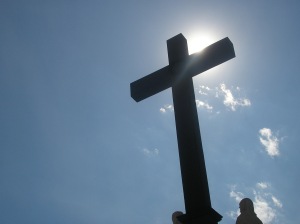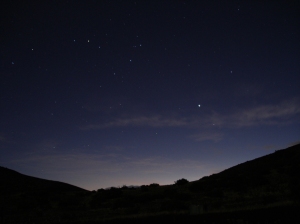The cross is a symbol of all that is difficult and oppressive and so against human nature. In the writings of St. John of the Cross, however, the prevailing symbol is not the cross but night. What is meant by ‘symbol’? In The Science of the Cross, St. Teresa Benedicta of the Cross explains that in the broad sense a symbol is everything sensory by which something spiritual is significant. It is everything familiar through natural experience that signifies something unfamiliar (or even that is not perceived naturally). In this broad sense night and cross are symbols.
A sign can be used in place of a symbol; however, a symbol usually represents a broader range of meaning. An image can also represent someone or something. The difference between a sign and an image is that an image is a likeness; it points to what is image through inner similarity. For example, an image is like a reflection in a mirror. Whoever sees it will immediately be directed through it to the original that is recognized in that image. A sign has no such substantial agreement; the relation is arbitrary. A sign has an arbitrary meaning attached to it that must be told in order to understand it. For instance, a red octagon shape with white letters on it is a commonly recognized sign. A meaning is given to that sign. All, then, understand that meaning and know to stop when it is seen.
The cross is not an image in the strict sense as a symbol is in the broad sense above because there is no immediate perceptibility of similarity between the cross and suffering. The cross has acquired this meaning. It is a sign, but not one that was artificially given to it. It is because of history and its use as a tool that gives the cross this meaning. The cross earned its meaning.

As an emblem the cross is a symbol or figure adopted and used as an identifying mark. Christians identify with this emblem. They will sometimes wear a cross as an identification that they are a Christian.
In contrast with the cross, night is natural, the counterpart of light. It is not literally an object because it is not visible. Night is the absence of light and, though invisible and formless, it can, interestingly, still be perceived.
St. Teresa Benedicta describes, in The Science of the Cross, how night symbolizes the cross, that is in all that is difficult, oppressive and contrary to the will, because it limits the use of the senses, limits the use of movements, weakness strength, banishes in loneliness, and makes shadowy and ghostly.
The physical night, the night of nature, is similar to the spiritual night, or death, that St. John of the Cross describes with this difference: the physical or natural night of human experience is “the moonlight magic night”. Everything in natural night is flooded by a mild soft night. “This softly lit night does not devour things, but instead gives them a glowing nocturnal visage” (appearance). Things can be seen in this “moonlight magic night” only they are not as sharp or clear, rather they are “muted and soothed”. The saint goes on to note that “characteristic traits are revealed that never appear in bright daylight.” What an interesting perspective. An example would be, if while trying to sleep while staying in a noisy, busy part of a town, the quiet hum of the interstate traffic that was drowned out by all the other activity that went on during the day could be heard off in the distance now that it is night and the daytime hustle and bustle has ceased.

So, the night is good and has value, just like the mystical night does. Natural nightfall “puts an end to the haste and noise of the day, it brings rest and peace.” This has a correlation with the spiritual “night”. The spirit is “freed from the drudgery of the days duties, relaxed and recollected, at the same time it is absorbed in the profound relationships of its own being and life, of the word and the world beyond. And there is a deep, grateful repose in the peace of night.”
In order to understand St. John of the Cross it must be kept in mind one important difference between this mystical, spiritual night and this natural night symbolism. Natural night imposes itself from outside. This mystical night “does not impose itself on us from without, but rather has its origin in the interior of the soul and affects only this single soul in whom it arises.”
The effect this night has on the interior of the soul can be compared to the effects that natural light has:
“it entails a submersion of the exterior world event though outside it is bathed in bright daylight. It casts the soul into loneliness, desolation and emptiness, stays the activity of all her faculties, frightens her by threatening horrors it conceals within itself.”
Since this is all taking place interiorly in the soul, to look on someone who is experiencing this, would be no different than looking at someone who isn’t experiencing this night. It is all interior.
However, “there is also a nocturnal light that reveals a new world deep in the interior and at the same time illumines the outer world from within so that this outer is given back to us entirely transformed.”
[The Science of the Cross, Edith Stein (pages 35-42), ICS Publications]




